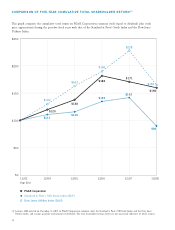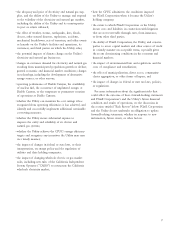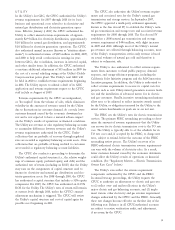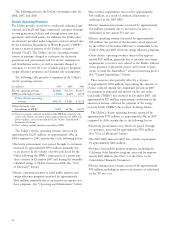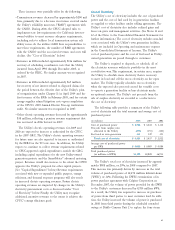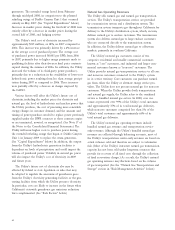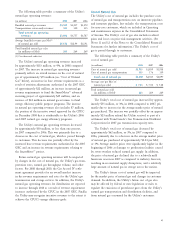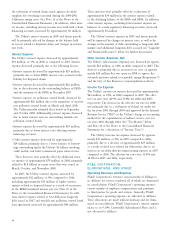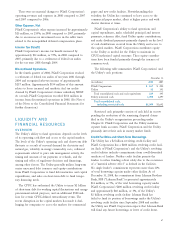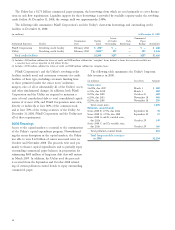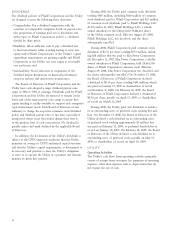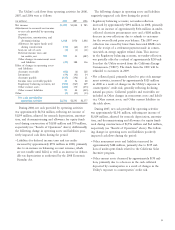PG&E 2008 Annual Report Download - page 43
Download and view the complete annual report
Please find page 43 of the 2008 PG&E annual report below. You can navigate through the pages in the report by either clicking on the pages listed below, or by using the keyword search tool below to find specific information within the annual report.
41
Cost of Electricity
The Utility’s cost of electricity includes the cost of purchased
power and the cost of fuel used by its generation facilities
or supplied to other facilities under tolling agreements. The
Utility’s cost of electricity also includes realized gains and
losses on price risk management activities. (See Notes 11 and
12 of the Notes to the Consolidated Financial Statements for
further information.) The cost of electricity excludes non-fuel
costs associated with the Utility’s own generation facilities,
which are included in Operating and maintenance expense
in the Consolidated Statements of Income. The Utility’s
cost of purchased power and the cost of fuel used in Utility-
owned generation are passed through to customers.
The Utility is required to dispatch, or schedule, all of
the electricity resources within its portfolio in the most
cost-effective way. This requirement, in certain cases, requires
the Utility to schedule more electricity than is necessary
to meet its load and sell the excess electricity on the open
market. The Utility typically schedules excess electricity
when the expected sales proceeds exceed the variable costs
to operate a generation facility or buy electricity under
an optional contract. The Utility’s net proceeds from the
sale of surplus electricity are recorded as a reduction to
the cost of electricity.
The following table provides a summary of the Utility’s
cost of electricity and the total amount and average cost of
purchased power:
(in millions) 2008 2007 2006
Cost of purchased power $ 4,516 $ 3,443 $ 3,114
Proceeds from surplus sales
allocated to the Utility (255) (155) (343)
Fuel used in own generation 164 149 151
Total cost of electricity $ 4,425 $ 3,437 $ 2,922
Average cost of purchased power
per kWh $ 0.088 $ 0.089 $ 0.084
Total purchased power
(in millions of kWh) 51,100 38,828 36,913
The Utility’s total cost of electricity increased by approxi-
mately $988 million, or 29%, in 2008 compared to 2007.
This increase was primarily driven by increases in the total
volume of purchased power of 12,272 million kilowatt-hours
(“kWh”), or 32%. Following the DWR’s termination of its
power purchase agreement with Calpine Corporation in
December 2007, the volume of power provided by the DWR
to the Utility’s customers decreased by 8,784 million kWh.
As a result, the Utility was required to increase its purchases
of power from third parties to meet customer load. In addi-
tion, the Utility increased the volume of power it purchased
in 2008 from third parties during the scheduled extended
outage at Diablo Canyon Unit 2 to replace the four steam
These increases were partially offset by the following:
• Transmission revenues decreased by approximately $200 mil-
lion, primarily due to a decrease in revenues received under
the Utility’s reliability must run (“RMR”) agreements with
the CAISO. During 2006, the CPUC adopted rules to
implement state law requirements for California investor-
owned utilities to meet resource adequacy requirements,
including rules to address local transmission system reli-
ability issues. As the utilities fulfi ll their responsibilities to
meet these requirements, the number of RMR agreements
with the CAISO and the associated revenues and costs will
decline. (See “Cost of Electricity” below.)
• Revenues in 2006 included approximately $136 million for
recovery of scheduling coordinator costs that the Utility
incurred from April 1998 through December 2005, as
ordered by the FERC. No similar amount was recognized
in 2007.
• Revenues in 2006 included approximately $65 million
for recovery of net interest related to disputed claims for
the period between the effective date of the Utility’s plan
of reorganization under Chapter 11 in April 2004 and the
fi rst issuance of the ERBs in February 2005, and for certain
energy supplier refund litigation costs upon completion
of the CPUC’s 2005 Annual Electric True-up verifi cation
audit. No similar amount was recognized in 2007.
• Other electric operating revenues decreased by approximately
$58 million, refl ecting a pension revenue requirement that
was recovered in 2006 but not in 2007.
The Utility’s electric operating revenues for 2009 and
2010 are expected to increase as authorized by the CPUC
in the 2007 GRC. The Utility’s electric operating revenues
for future years are also expected to increase as authorized
by the FERC in the TO rate cases. In addition, the Utility
expects to continue to collect revenue requirements related
to CPUC-approved capital expenditures outside the GRC,
including capital expenditures for the new Utility-owned
generation projects and the SmartMeter™ advanced metering
project. Revenues would also increase to the extent the CPUC
approves the Utility’s proposal for other capital projects.
(See “Capital Expenditures” below.) Revenue requirements
associated with new or expanded public purpose, energy
effi ciency, and demand response programs will also result
in increased electric operating revenues. Future electric
operating revenues are impacted by changes in the Utility’s
electricity procurement costs as discussed under “Cost
of Electricity” below. Finally, the Utility may recognize
additional incentive revenues to the extent it achieves the
CPUC’s energy effi ciency goals.



